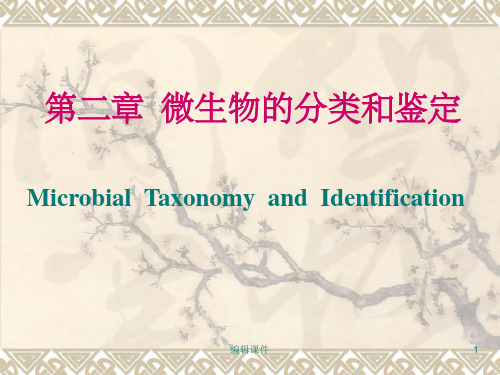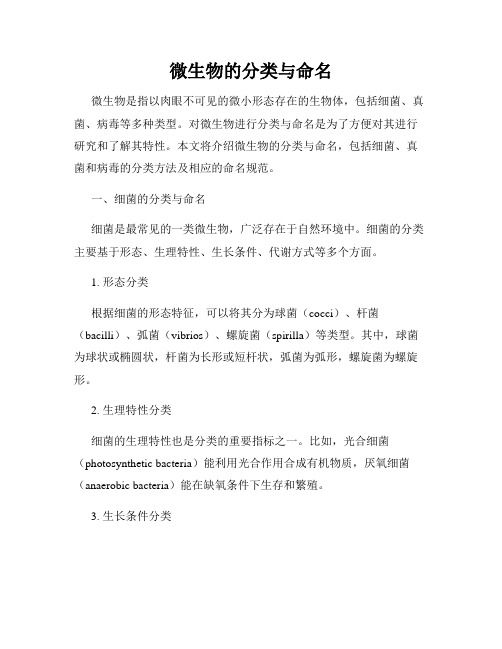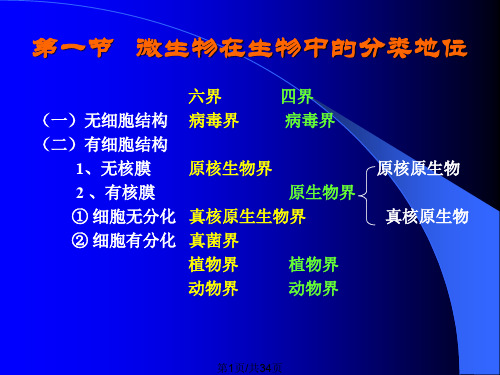第二章 微生物的分类与命名
- 格式:pdf
- 大小:1.22 MB
- 文档页数:50






微生物的分类与命名微生物是指以肉眼不可见的微小形态存在的生物体,包括细菌、真菌、病毒等多种类型。
对微生物进行分类与命名是为了方便对其进行研究和了解其特性。
本文将介绍微生物的分类与命名,包括细菌、真菌和病毒的分类方法及相应的命名规范。
一、细菌的分类与命名细菌是最常见的一类微生物,广泛存在于自然环境中。
细菌的分类主要基于形态、生理特性、生长条件、代谢方式等多个方面。
1. 形态分类根据细菌的形态特征,可以将其分为球菌(cocci)、杆菌(bacilli)、弧菌(vibrios)、螺旋菌(spirilla)等类型。
其中,球菌为球状或椭圆状,杆菌为长形或短杆状,弧菌为弧形,螺旋菌为螺旋形。
2. 生理特性分类细菌的生理特性也是分类的重要指标之一。
比如,光合细菌(photosynthetic bacteria)能利用光合作用合成有机物质,厌氧细菌(anaerobic bacteria)能在缺氧条件下生存和繁殖。
3. 生长条件分类根据细菌的生长条件不同,可以将其分为嗜热菌(thermophile)、嗜酸菌(acidophile)、嗜盐菌(halophile)等类型。
嗜热菌适应高温环境,嗜酸菌适应酸性环境,嗜盐菌适应高盐浓度环境。
细菌的命名通常遵循国际细菌命名法规定的规范。
该规范要求使用拉丁文或拉丁化的词根作为细菌的属名(genus),并加上表征特定种类的表名(specific epithet)。
例如,大肠杆菌(Escherichia coli)中,“Escherichia”为属名,“coli”为表名。
二、真菌的分类与命名真菌是一类具有真核细胞结构的微生物,包括酵母菌和霉菌等。
真菌根据其生活方式、营养特性和菌丝形态等进行分类。
1. 营养分类真菌的营养方式主要分为 saprophytes(腐生菌)和 parasites(寄生菌)。
腐生菌通过分解死物质为自己提供营养,寄生菌则寄生于其他寄主生物体上。
2. 菌丝形态分类真菌的菌丝形态也是分类的依据之一。



微生物的分类与命名以啤酒酵母为例,它在分类学上的地位是:界(Kindom):真菌界门(Phyllum):真菌门纲(Class):子囊菌纲目(Order):内孢霉目科(Family):内孢霉科属(Genus):酵母属种(Species):啤酒酵母(一)、微生物的分类单位界、门、纲、目、科、属、种种是最基本的分类单位每一分类单位之后可有亚门、亚纲、亚目、亚科...种的概念定义:种是一个基本分类单位,是一大群表型特征高度相似、亲缘关系极其接近、与同属内其他种有明显差异的菌株的总称。
在微生物中,一个种只能用该种内的一个典型菌株作为具体标本,它就是该种的模式种。
新种:sp.nov.或nov. sp.,新被鉴定的种发表时应在其学名后标上sp.nov.的符号,新种发表前应将其模式菌株的培养物存放在一个永久性的保藏机构,并应允许人们从中取得。
1. 种(species):是一个基本分类单位;是一大群表型特征高度相似、亲缘关系极其接近,与同属内其他种有明显差别的菌株的总称。
①菌株(strain): 表示任何由一个独立分离的单细胞繁殖而成的纯种群体及其一切后代(起源于共同祖先并保持祖先特性的一组纯种后代菌群)。
因此,一种微生物的不同来源的纯培养物均可称为该菌种的一个菌株。
菌株强调的是遗传型纯的谱系。
例如:大肠埃希氏杆菌的两个菌株:Escherichia coli B 和Escherichia coli K12★菌株的表示法:★如果说种是分类学上的基本单位,那末菌株实际上是应用的基本单位,因为同一菌种的不同菌株在产酶上种类或代谢物产量上会有很大的不同和差别!微生物的分类单位-2②亚种(subspecies)或变种(variety):为种内的再分类。
当某一个种内的不同菌株存在少数明显而稳定的变异特征或遗传形状,而又不足以区分成新种时,可以将这些菌株细分成两个或更多的小的分类单元——亚种。
变种是亚种的同义词,因“变种”一词易引起词义上的混淆,从1976年后,不在使用变种一词。


微生物常见考点总结第一章绪论一、微生物的分类及命名1、微生物的分类等级为界、门、纲、目、科、属、种,种是最基本的分类单位。
目前国际上普遍采用的分类系统是伯杰分类系统。
2、根据微生物的大小、结构和组成不同,分为三大类型:(1)非细胞型微生物:此类微生物无细胞结构,由一种核酸和蛋白衣壳组成,必须寄生在活细胞内才能生长繁殖。
如病毒、类病毒和朊病毒(又称朊粒)。
(2)原核细胞型微生物:此类微生物由单细胞组成,细胞核分化程度低,无核膜、核仁,染色体为裸露的DNA分子,缺乏完整的细胞器。
如细菌、支原体、衣原体、立克次体和螺旋体。
(3)真核细胞型微生物:此类微生物细胞核分化程度高,有核膜、核仁、完整的细胞器。
如真菌、单细胞藻类。
3、每种细菌DNA中的G(鸟嘌呤)+C(胞嘧啶)含量摩尔百分比有一定范围,变化不大,DNA(G+C)mol%可以作为细菌分类的一个重要依据。
4、微生物命名由属名和种名组成,中文命名种名在前,属名在后。
拉丁文则相反。
如:Mycobacterium tuberculosis中文名: 种名+ 属名例: 结核分枝杆菌二、微生物的发展1、荷兰人列文虎克发明了显微镜,人类第一次观察到微生物。
2、法国科学家巴斯德被称为“微生物学之父”。
3、1929年,弗莱明发现了青霉素。
1940年Florey和Chain将青霉素分离提纯,应用于临床。
5、德国医生郭霍证明了微生物是传染病的致病因子。
第二章细菌的基本性状一、细菌的形态与结构(一)细菌的大小和形态1、细菌个体微小,通常以微米作为测量单位。
2、细菌的基本形态有三类:球菌、杆菌、螺形菌。
(二)细菌的基本结构1、细菌的基本结构由外向内依次是细胞壁、细胞膜、细胞质和核质。
2、根据细胞壁的化学组成与结构不同,用革兰染色将细菌分为G+和G-两大类。
3、磷壁酸是革兰阳性菌细胞壁特有的结构,壁磷壁酸为革兰阳性菌的重要表面抗原,膜磷壁酸为黏附因子。
4、外膜层是革兰阴性菌特细胞壁的特殊成分,从外向内依次是脂多糖、脂质双层、脂蛋白。

微生物的分类和命名规则微生物是一类微小的生物体,包括细菌、真菌、病毒等。
正确分类和命名微生物对于研究其特性、功能以及与人类的关系至关重要。
本文将介绍微生物的分类和命名规则。
一、微生物的分类1. 界(kingdom):微生物可以分为五个界,即细菌界(Bacteria)、病毒界(Viruses)、真菌界(Fungi)、古细菌界(Archaea)和原生动物界(Protista)。
2. 门(phylum):每个界包含若干个门,用于进一步细分不同类型的微生物。
3. 纲(class):门下又可以划分为若干个纲,纲是进一步划分微生物种类的方式之一。
4. 目(order):在纲下,进一步的分类单位是目,用于确定微生物之间的更具体的关系。
5. 科(family):目下面是科,科是微生物分类中的一个重要单位,进一步细化了微生物的分类。
6. 属(genus):科下面是属,是对微生物进行更为具体的分类。
7. 种(species):最具体的分类单位是种,常以拉丁学名表示,包含科学名称和命名者的缩写。
二、微生物的命名规则1. 拉丁化命名:微生物的种命名通常使用拉丁学名,以便在不同语言之间保持一致。
2. 属名+种加词:微生物的种名通常由属名和种加词组成,种加词通常是为了描述或特指某种微生物,或者以某个人的名字命名。
如大肠杆菌(Escherichia coli),其中“Escherichia”是属名,而“coli”是种加词。
3. 学名缩写:在科学文献中,为了方便引用,可以使用微生物的学名缩写,通常是属名的首字母缩写加上种加词的首字母缩写。
例如,大肠杆菌的学名缩写为E. coli。
4. 命名者的缩写:在微生物的拉丁学名中,通常会包含命名者的缩写,以表明该微生物是由哪位科学家首次发现并命名的。
5. 国际命名规则:微生物的命名受到国际命名规则的约束,以确保命名的准确性和一致性。
三、案例分析以细菌为例,某科学家发现了一种新的细菌,并决定对其进行分类和命名。

微生物的分类和命名法微生物是一类非常特殊的生物体,在自然界中广泛存在,对环境生态和人类健康具有重要影响。
微生物的分类和命名法是对其进行科学归纳和命名的方法,以便于研究和交流。
本文将介绍微生物的分类原则和命名规则,以及这些方法在微生物学研究中的应用。
一、微生物的分类原则微生物的分类是基于其形态、生理特征、生态特征和遗传特征等方面进行的。
下面将介绍三个常用的微生物分类方法。
1. 形态分类法形态分类法是根据微生物的形态特征进行分类的方法。
仅限于通过直接观察和测量微生物形态特征的方法,如细胞形态、胞壁结构等。
常见的形态分类方法有鉴定微生物的颜色、大小、形状等。
2. 生理分类法生理分类法是以微生物的生理过程和生物化学代谢为基础进行分类的方法。
根据微生物对环境中有机物的利用方式、产生特定产品的能力、对气体需求等特征进行分类。
例如,将细菌分为革兰氏阳性菌和革兰氏阴性菌,根据其细胞的染色结果和细胞壁结构。
3. 分子生物学分类法分子生物学分类法是通过研究微生物的基因组、核酸序列、拷贝数和基因型等遗传特征进行分类的方法。
这种分类方法可以更准确地判断微生物的亲缘关系。
常用的分子生物学分类方法有基因测序、DNA指纹图谱等。
二、微生物的命名法微生物的命名法是对微生物进行分类命名的规则,包括属名和种名的命名规则。
下面将介绍微生物的命名法的基本原则和命名规则。
1. 命名法的基本原则微生物的命名法遵循国际野生菌学和细菌学委员会(International Code of Nomenclature for Algae, Fungi, and Plants)制定的规则。
该委员会根据科学共识和实际需要,制定了一系列命名法的基本原则,以确保微生物的命名规范和稳定。
2. 种名的命名规则微生物的种名是由属名和种加词(trivial epithet)组成。
种加词是用来描述微生物特征的词汇,通常用拉丁文或其它国际科学语言表示。
种名应尽量与已有的命名规则保持一致,既要具有描述特征的准确性,又要易于记忆和使用。

微生物检验知识之细菌的分类与命名微生物检验知识之细菌的分类与命名细菌如何分类你知道吗?你对细菌的分类了解吗?下面是yjbys店铺为大家带来的关于细菌的分类的知识,欢迎阅读。
一、微生物在生物化学分类中的地位(一)细菌与原核生物界细菌、衣原体、立克次体、螺旋体、放线菌、支原体归属于原核生物界其分类等级依次为界、门、纲、目、科、属、种(二)真菌与真菌界真菌是真核细胞型微生物,归属真菌界(三)病毒与病毒界病毒没有典型的细胞结构,归属于病毒界病毒的`分类等级依次为科、属、种二、细菌的分类单位、系统和命名(一)细菌的分类单位细菌的分类等级为界、门、纲、目、科、属、种。
临床细菌检验常用的分类单位是科、属、种。
种是细菌分类的基本单位。
形态学和生理学性状相同的细菌群体构成一个菌种;性状相近、关系密切的若干菌种组成属;相近的属归为科,依次类推。
标准菌株:具有该种细菌典型特征的菌株在细菌的分类、鉴定和命名时都以标准菌株为依据标准菌株也可作为质量控制的标准(二)细菌的命名采用拉丁文双命名法:属名 (名词大写) + 种名 (形容词小写)(印刷用斜体)例: Mycobacterium tuberculosis中文名: 种名 + 属名例: 结核分枝杆菌(三)细菌的分类系统目前国际上普遍采用伯杰分类系统。
也有采用CDC(美国疾病预防和控制中心)分类系统。
三、细菌的分类方法(一)生理学与生物化学分类法1.传统分类法原则:生物的基本性质主次原则。
按细胞形态、革兰染色性、鞭毛及代谢特点作为较高一级分类依据。
科、属、种的分类主要依靠生化特性和抗原结构。
2.数值分类法原则:细菌的基本性质同等重要原则采用标准化、成品化和配套生化反应试剂条,检测细菌的数十个生理生化特性。
阴阳性结果—数字—电子计算机进行计算—比较、测定相似度—区分细菌的种群—确定细菌亲缘关系(二)遗传学分类法以细菌的核酸、蛋白质等在组成上的同源程度分类。
目前较为稳定的遗传学的分类方法有下列几种:1.DNA G+C mol测定,简称G-C比。

微生物的分类与命名微生物广泛存在于我们周围的环境中,是生命中极为重要的一部分。
而微生物的分类与命名则是研究微生物领域的基础知识之一。
本文将介绍微生物的分类与命名的相关知识,帮助读者更好地了解微生物的世界。
一、微生物的分类微生物按照其形态特征和生长习性可以分为原核生物和真核生物两大类。
原核生物又可以分为细菌和古细菌两个域,真核生物包括原生动物、酵母菌、霉菌和藻类等多个类群。
细菌是一类普遍存在于自然界中的微生物,具有单细胞结构和简单的细胞结构。
古细菌则是生命的三大域之一,具有相对特殊的生存环境和适应特性。
二、微生物的命名微生物的命名主要遵循国际微生物命名法规定的规范。
微生物按照属、种的分类顺序进行命名,例如:大肠杆菌属(Escherichia)大肠杆菌种(E.coli)。
在微生物的命名中,拉丁或希腊语是最常用的命名语言,以确保不同国家和地区都可以明确理解。
此外,微生物的命名还要遵循唯一性原则,确保每个微生物种类的名称都是独一无二的。
三、微生物的分类与命名的意义微生物的分类与命名不仅有助于科学家更好地理解和研究微生物的多样性和进化历史,也为微生物在医学、农业和环境等领域的应用提供了重要依据。
通过对微生物的分类与命名,我们可以更好地认识微生物的特性和功能,推动微生物学领域的研究和发展。
总结:微生物的分类与命名是微生物学研究的基础,通过了解微生物的分类体系和命名规范,我们可以更好地理解微生物的多样性和重要性。
希望本文能帮助读者更好地了解微生物的分类与命名知识,促进微生物学领域的学术研究和应用发展。


细菌的分类与命名细菌分类学细菌分类学(taxonom y)是指对细菌进行分类、命名与鉴定的一门学科。
它的任务是在全面了解细菌的生物学特征的基础上,研究它们的种类,探索其起源、演化以及与其他类群之间的亲缘关系,进而提出能反映自然发展的分类系统,并将细菌加以分门别类。
它包括三个方面:分类(classif icatio n)、命名(nomencl ature)和鉴定(identif icatio n)。
一、基本概念1.细菌分类是根据每种细菌各自的特征,并按照它们的亲缘关系分门别以细菌的形态和生理生化特性为依类,以不同等级编排成系统。
分类有两种:①据的表型特征分类法,包括有传统分类法(classic al classif icatio n)和数值分类法(numeric al classif icatio n);②用化学分析和核酸分析,以细菌大分子物质(核酸、蛋白质)结构的同源程度进行分类称种系分类(phyloge neticclassif icatio n)或自然分类(natural classfi cation)。
2.细菌命名在分类基础上,给予每种细菌一个科学名称,使之在生产实践、临床实践和科学研究工作中相互交流成为可能。
按照细菌命名的法规,能保证所有的科研工作者以同样方式给予细菌命名。
3.细菌鉴定将未知细菌按分类原则放入系统中某一适当位置和已知细菌比较其相似性,用对比分析方法确定细菌的分类地位。
若与已知细菌相同即采用已知菌的名称,不同者则按命名原则确定一个新名称。
二、分类等级细菌的分类等级和其他生物相同,依次为界(kingdom)、门(divisio n)、纲(class)、目(order)、科(family)、属(genus)、种(species)。